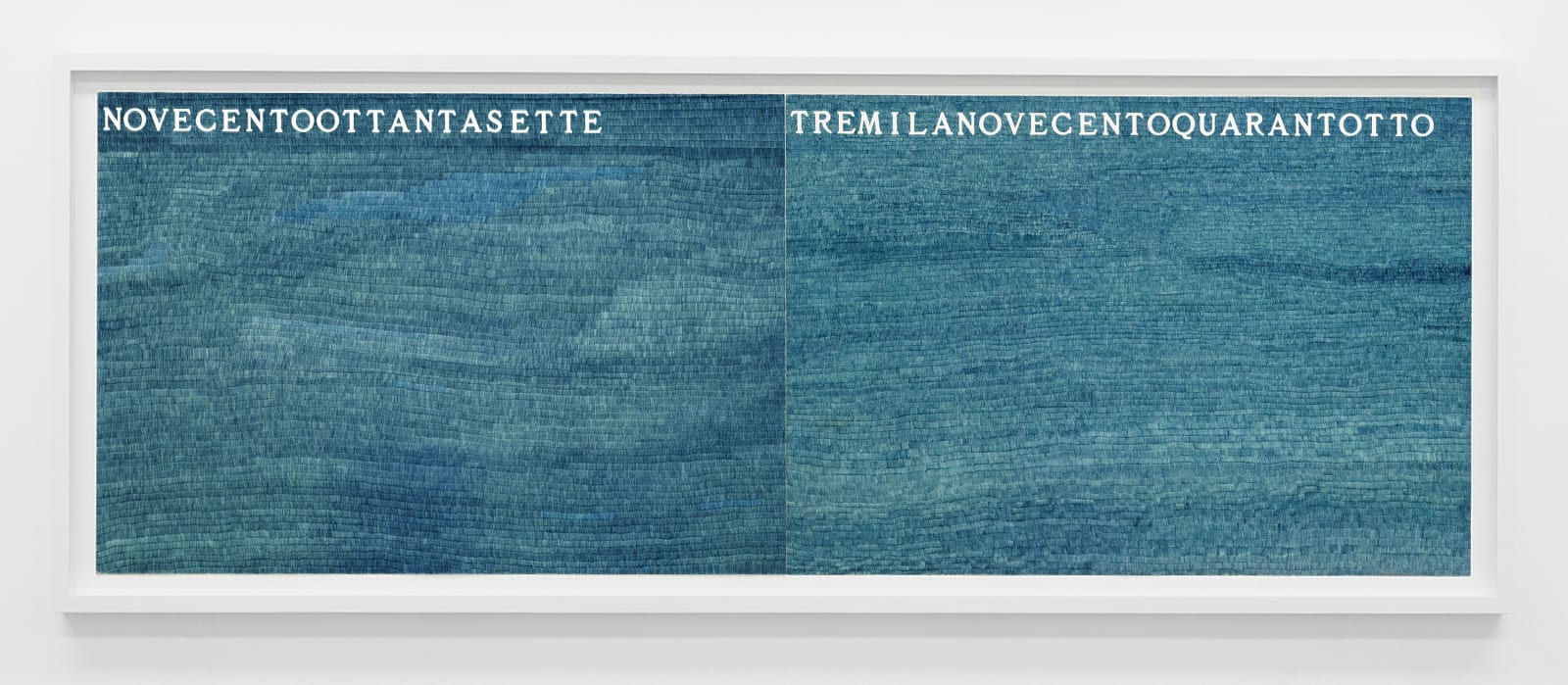



Alighiero Boetti Italian, 1940-1994
La Metà e il Doppio, 1974
Ballpoint pen on paper
2 parts, 70 x 100 cm. (27 1/2 x 39 3/8 in.) each / 70 x 200 cm. (27 1/2 x 78 3/4 in.) total
Copyright The Artist
Further images
Alighiero Boetti’s La Metà e il Doppio (1974) is a masterful example of his celebrated Biro works, demonstrating his rigorous engagement with conceptual systems, numerical relationships, and the nature of...
Alighiero Boetti’s La Metà e il Doppio (1974) is a masterful example of his celebrated Biro works, demonstrating his rigorous engagement with conceptual systems, numerical relationships, and the nature of artistic authorship. Executed in two panels of dense blue biro marks, meticulously applied by his studio assistants, the work is punctuated by negative-space inscriptions at the top: “NOVECENTOOTTANTASETTE” (987) and “REMILANOVECENTOQUARANTOTTO” (3,948). The stark contrast between these luminous white numerals and the undulating ocean of biro hatching gives the work with a sense of coded meaning – one that is reinforced by its title, La Metà e il Doppio (Half and Double).
Boetti’s preoccupation with mathematical structures and conceptual frameworks finds lucid expression here. The numerical relationship embedded in the work is precise: 3,948 is exactly four times 987, enacting a visual and mathematical meditation on doubling and multiplication. By structuring the composition across two panels, Boetti further underscores the idea of duality and proportion, aligning with his broader artistic investigations into symmetry, order, and systemic logic. The work thus operates as both an aesthetic object and an intellectual proposition, inviting the viewer to decipher its internal relationships.
The Biro works mark a critical phase in Boetti’s practice, embodying his fascination with both rigorous order and the inherent unpredictability of human labour. From 1972 onwards, Boetti engaged assistants to execute vast fields of cross-hatched biro, transforming a quotidian writing instrument into the vehicle for intricate, highly textured surfaces. While Boetti dictated the conceptual framework – outlining forms, words, and structures – the execution was left to his team, whose individual gestures subtly disrupted the work’s apparent uniformity. This interplay between the mechanical and the organic, the systematic and the subjective, exemplifies the conceptual tensions at the heart of Boetti’s practice.
Boetti’s La Metà e il Doppio thus stands as a paradigmatic expression of his singular artistic vision – an intersection of conceptual clarity, aesthetic refinement, and philosophical inquiry. In its meticulous construction and layered meanings, it encapsulates Boetti’s enduring fascination with the relationship between order and chance, logic and intuition, singularity and multiplicity. As with the finest of Boetti’s works, it offers a space for contemplation, where the visual and the intellectual coalesce into a single, resonant whole.
Boetti’s preoccupation with mathematical structures and conceptual frameworks finds lucid expression here. The numerical relationship embedded in the work is precise: 3,948 is exactly four times 987, enacting a visual and mathematical meditation on doubling and multiplication. By structuring the composition across two panels, Boetti further underscores the idea of duality and proportion, aligning with his broader artistic investigations into symmetry, order, and systemic logic. The work thus operates as both an aesthetic object and an intellectual proposition, inviting the viewer to decipher its internal relationships.
The Biro works mark a critical phase in Boetti’s practice, embodying his fascination with both rigorous order and the inherent unpredictability of human labour. From 1972 onwards, Boetti engaged assistants to execute vast fields of cross-hatched biro, transforming a quotidian writing instrument into the vehicle for intricate, highly textured surfaces. While Boetti dictated the conceptual framework – outlining forms, words, and structures – the execution was left to his team, whose individual gestures subtly disrupted the work’s apparent uniformity. This interplay between the mechanical and the organic, the systematic and the subjective, exemplifies the conceptual tensions at the heart of Boetti’s practice.
Boetti’s La Metà e il Doppio thus stands as a paradigmatic expression of his singular artistic vision – an intersection of conceptual clarity, aesthetic refinement, and philosophical inquiry. In its meticulous construction and layered meanings, it encapsulates Boetti’s enduring fascination with the relationship between order and chance, logic and intuition, singularity and multiplicity. As with the finest of Boetti’s works, it offers a space for contemplation, where the visual and the intellectual coalesce into a single, resonant whole.



